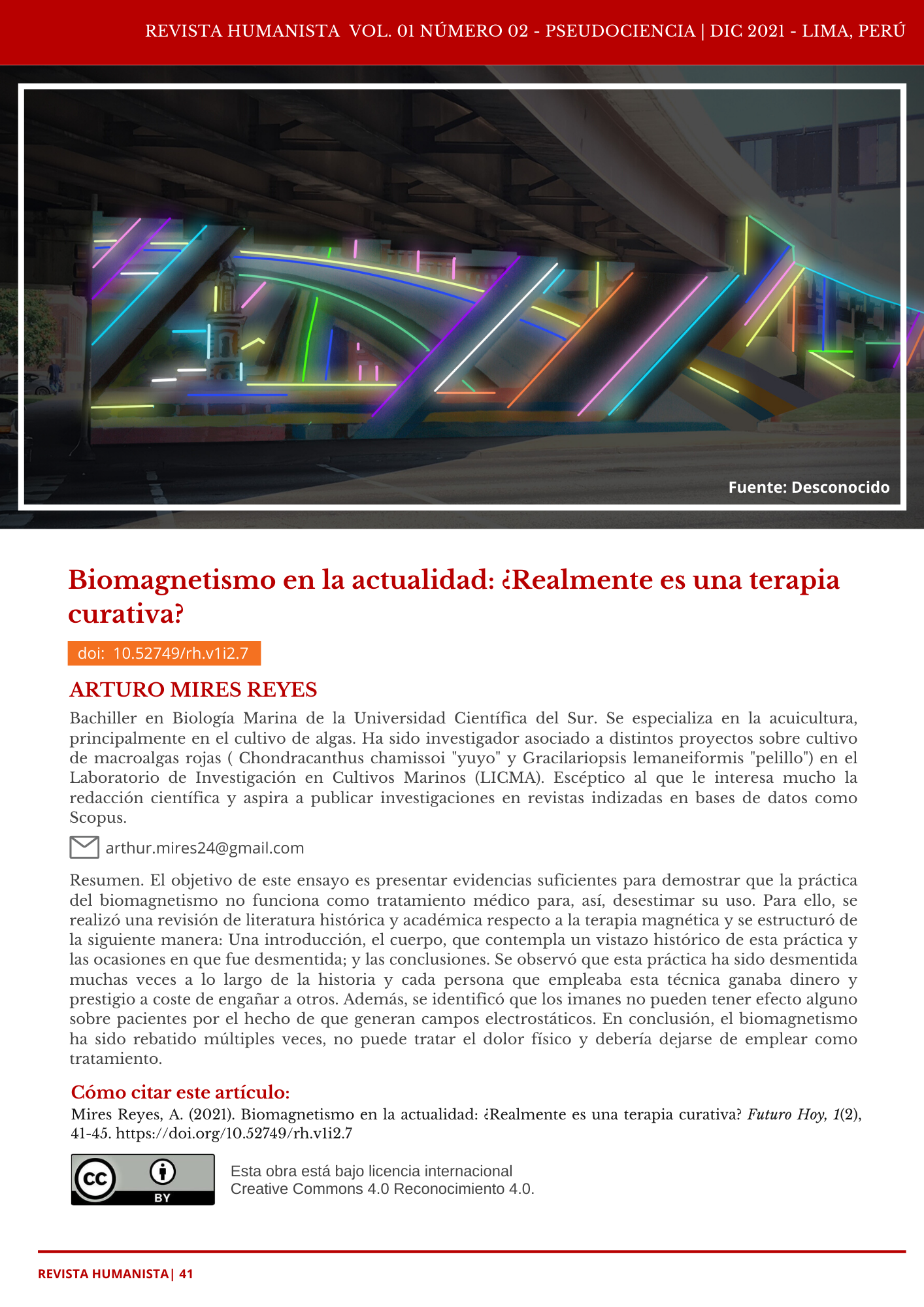Biomagnetismo en la actualidad: ¿Realmente es una terapia curativa?
DOI:
https://doi.org/10.52749/rh.v1i2.7Palabras clave:
biomagnetismo, pseudociencia, medicina alternativaResumen
El objetivo de este ensayo es presentar evidencias suficientes para demostrar que la práctica del biomagnetismo no funciona como tratamiento médico para, así, desestimar su uso. Para ello, se realizó una revisión de literatura histórica y académica respecto a la terapia magnética y se estructuró de la siguiente manera: Una introducción, el cuerpo, que contempla un vistazo histórico de esta práctica y las ocasiones en que fue desmentida; y las conclusiones. Se observó que esta práctica ha sido desmentida muchas veces a lo largo de la historia y cada persona que empleaba esta técnica ganaba dinero y prestigio a coste de engañar a otros. Además, se identificó que los imanes no pueden tener efecto alguno sobre pacientes por el hecho de que generan campos electrostáticos. En conclusión, el biomagnetismo ha sido rebatido múltiples veces, no puede tratar el dolor físico y debería dejarse de emplear como tratamiento.
Descargas
Citas
Alonso, F., & Cortiñas, S. (2014). La pseudociencia como (des) información tóxica. Una taxonomía para comprender el fenómeno y sus manifestaciones. Ámbitos. Revista internacional de comunicación, (24). https://institucionales.us.es/ambitos/la-pseudociencia-como-desinformacion-toxica-una-taxonomia-para-comprender-el-fenomeno-y-sus-manifestaciones/
Butterfield, J. (1991). Dr Gilbert’s magnetism. The Lancet, 338(8782-8783), 1576–1579. https://doi.org/10.1016/0140-6736(91)92388-i
Collacott, E. A., Zimmerman, J. T., White, D. W., & Rindone, J. P. (2000). Bipolar permanent magnets for the treatment of chronic low back pain: a pilot study. Journal of the American Medical Association, 283(10): 1322-1325. https://doi.org/10.1001/jama.283.10.1322
Finegold, L., & Flamm, B. L. (2006). Magnet therapy. The British Medical Journal, 332:4. https://doi.org/10.1136/bmj.332.7532.4
González, A. (2003). Magnetismo y Pseudociencia en la Medicina. Revista Cubana de Física, 20(1): 59-64. http://www.revistacubanadefisica.org/RCFextradata/OldFiles/2003/Vol.%2020,%20No.%201/20103-11.PDF
González, A. (2007). The Magnetotherapy Delusion. Revista Cubana de Física, 24(2): 122-126. http://www.revistacubanadefisica.org/index.php/rcf/article/view/RCF_24_2_122
Grupo Español de Pacientes con Cáncer (GEPAC). (2017). Mitos y pseudoterapiss creados en torno al cáncer. Grupo Español de Pacientes con Cáncer (GEPAC), 168 pp. http://www.gepac.es/multimedia/gepac2016/pdf/LIBRO_MITOS_Y_PSEUDOTERAPIAS.pdf
Haygarth, J. (1800). Of the Imagination, as a Cause and Cure of Disorders of the Body, exemplified by Fictitious Tractors. Annals of Medicine, For the Year, 5: 133-145. https://www.ncbi.nlm.nih.gov/pmc/articles/PMC5111928/
Häfeli, U. (2006). The History of Magnetism in Medicine. En: W. Andrä, & H. Nowak (Eds.) Magnetism in Medicine: A Handbook (2nd Edition) (pp. 3-25). Wiley-VCH Verlag GmbH & Co. https://doi.org/10.1002/9783527610174.ch1a
Lai, H., & Singh, N. P. (2004). Magnetic-field-induced DNA strand breaks in brain cells of the rat. Environmental health perspectives, 112(6): 687-694. https://doi.org/10.1289%2Fehp.6355
Macklis, R. M. (1993). Magnetic healing, quackery, and the debate about the health effects of electromagnetic fields. Annals of Internal Medicine, 118(5): 376-383. https://doi.org/10.7326/0003-4819-118-5-199303010-00009
Milstead, K. L., Davis, J. B., & Dobelle, M. (1964). Quackery in the Medical Device Field. Physical Therapy, 44(7): 654–662. https://doi.org/10.1093/ptj/44.7.654
Mourino, M. R. (1991). From Thales to Lauterbur, or from the lodestone to MR imaging: magnetism and medicine. Radiology, 180(3): 593–612. https://doi.org/10.1148/radiology.180.3.1871268
Peterson, F., & Kennelly, A. E. (1892). Some physiological experiments with magnets at the Edison Laboratory. New York Medical Journal, 56, 729-732.
Richmond, S. J., Brown, S. R., Campion, P. D., Porter, A. J., Moffett, J. A. K., Jackson, D. A., ... & Taylor, A. J. (2009). Therapeutic effects of magnetic and copper bracelets in osteoarthritis: a randomised placebo-controlled crossover trial. Complementary Therapies in Medicine, 17(5-6): 249-256. https://doi.org/10.1016/j.ctim.2009.07.002
Richmond, S. J., Gunadasa, S., Bland, M., & MacPherson, H. (2013). Copper bracelets and magnetic wrist straps for rheumatoid arthritis–analgesic and anti-inflammatory effects: a randomised double-blind placebo controlled crossover trial. PloS One, 8(9): e71529. https://doi.org/10.1371%2Fjournal.pone.0071529
Windle, B. C. (1895). The Effects of Electricity and Magnetism on Development. Journal of Anatomy and Physiology, 29(Pt 3): 346. https://www.ncbi.nlm.nih.gov/pmc/articles/PMC1328408/
Winemiller, M. H., Billow, R. G., Laskowski, E. R., & Harmsen, W. S. (2003). Effect of magnetic vs sham-magnetic insoles on plantar heel pain: a randomized controlled trial. Journal of the American Medical Association, 290(11): 1474-1478. https://doi.org/10.1001/jama.290.11.1474

Descargas
Publicado
Cómo citar
Número
Sección
Licencia
Derechos de autor 2021 Arturo Mires Reyes

Esta obra está bajo una licencia internacional Creative Commons Atribución 4.0.
El autor de cada artículo o contribución académica publicada en la Revista Humanista se compromete a otorgar derechos de uso a otros gracias al registro en Creative Commons BY 4.0 que la Editorial ha tramitado para su obra. Esto permite el acceso gratuito e inmediato a la obra y permite a cualquier usuario leer, descargar, copiar, distribuir, imprimir, buscar o vincular acceder a los textos completos de los artículos, rastrearlos para indexarlos, pasarlos como datos al software o utilizarlos para cualquier otro propósito legal. Cada autor mantiene los derechos de su obra. La Revista Humanista posee los derechos de publicación de cada artículo. La revista no se responsabiliza por los comentarios vertidos por cada autor.



